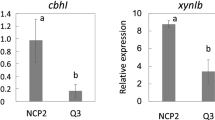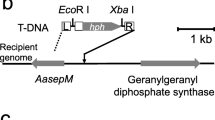Abstract
The serine–arginine protein kinase–like protein, SrpkF, was identified as a regulator for the cellulose-responsive induction of cellulase genes in Aspergillus aculeatus. To analyze various aspects of SrpkF function, we examined the growth of the control strain (MR12); C-terminus deletion mutant, which produced SrpkF1–327 (ΔCsrpkF); whole gene-deletion mutant of srpkF (ΔsrpkF), srpkF overexpressing strain (OEsprkF); and the complemented strain (srpkF+) under various stress conditions. All test strains grew normally on minimal medium under control, high salt (1.5 M KCl), and high osmolality (2.0 M sorbitol and 1.0 M sucrose). However, only ΔCsrpkF showed reduced conidiation on 1.0 M NaCl media. Conidiation of ΔCsrpkF on 1.0 M NaCl media was reduced to 12% compared with that of srpkF+. Further, when OEsprkF and ΔCsrpkF were pre-cultured under salt stress conditions, germination under salt stress conditions was enhanced in both strains. By contrast, deletion of srpkF did not affect hyphal growth and conidiation under the same conditions. We then quantified the transcripts of the regulators involved in the central asexual conidiation pathway in A. aculeatus. The findings revealed that the expression of brlA, abaA, wetA, and vosA was reduced in ΔCsrpkF under salt stress. These data suggest that in A. aculeatus, SrpkF regulates conidiophore development. The C-terminus of SrpkF seems to be important for regulating SrpkF function in response to culture conditions such as salt stress.





Similar content being viewed by others
Data availability
All data generated or analyzed during this study are included in this published article and its Supplementary Information files. DNA sequences will be available in the DDBJ database.
Code availability
Not applicable.
References
Adachi H, Tani S, Kanamasa S, Sumitani J, Kawaguchi T (2009) Development of a homologous transformation system for Aspergillus aculeatus based on the sC gene encoding ATP-sulfurylase. Biosci Biotechnol Biochem 73:1197–1199. https://doi.org/10.1271/bbb.80772
Baba Y, Sumitani J, Tani S, Kawaguchi T (2015) Characterization of Aspergillus aculeatus b-glucosidase 1 accelerating cellulose hydrolysis with Trichoderma cellulase system. AMB Express 5:3. https://doi.org/10.1186/s13568-014-0090-3
Baltussen TJH, Zoll J, Verweij PE, Melchers WJG (2020) Molecular mechanisms of conidial germination in Aspergillus spp. Microbiol Mol Biol Rev 84:1–31. https://doi.org/10.1128/MMBR.00049-19
Blom N, Sicheritz-Ponten T, Gupta R, Gammeltoft S, Brunak S (2004) Prediction of post-translational glycosylation and phosphorylation of proteins from the amino acid sequence. Proteomics 4:1633–1649. https://doi.org/10.1002/pmic.200300771
Brewster JL, de Valoir T, Dwyer ND, Winter E, Gustin MC (1993) An osmosensing signal transduction pathway in yeast. Science 259:1760–1763. https://doi.org/10.1126/science.7681220
de Souza CP, Hashmi SB, Osmani AH, Andrews P, Ringelberg CS, Dunlap JC, Osmani SA (2013) Functional analysis of the Aspergillus nidulans kinome. PLoS One 8:e58008. https://doi.org/10.1371/journal.pone.0058008
de Vries RP, Riley R, Wiebenga A, Aguilar-Osorio G, Amillis S, Uchima CA, Anderluh G, Asadollahi M, Askin M, Barry K, Battaglia E, Bayram O, Benocci T, Braus-Stromeyer SA, Caldana C, Canovas D, Cerqueira GC, Chen F, Chen W et al (2017) Comparative genomics reveals high biological diversity and specific adaptations in the industrially and medically important fungal genus Aspergillus. Genome Biol 18:28. https://doi.org/10.1186/s13059-017-1151-0
Gams W, Christensen M, Onions AHS, Pitt JI, Samson RA (1986) Infrageneric taxa of Aspergillus. In: Samson RA, Pitt JI (eds) Advances in Penicillium and Aspergillus systematics, vol 102. NATO ASI Series, Springer, Boston, MA, p 55. https://doi.org/10.1007/978-1-4757-1856-0_5
Giannakouros T, Nikolakaki E, Mylonis I, Georgatsou E (2011) Serine-arginine protein kinases: a small protein kinase family with a large cellular presence. FEBS J 278:570–586. https://doi.org/10.1111/j.1742-4658.2010.07987.x
Gou LT, Lim DH, Ma W, Aubol BE, Hao Y, Wang X, Zhao J, Liang Z, Shao C, Zhang X, Meng F, Li H, Zhang X, Xu R, Li D, Rosenfeld MG, Mellon PL, Adams JA, Liu MF, Fu XD (2020) Initiation of parental genome reprogramming in fertilized oocyte by splicing kinase SRPK1-catalyzed protamine phosphorylation. Cell 180:1212–1227. https://doi.org/10.1016/j.cell.2020.02.020
Han KH, Prade RA (2002) Osmotic stress-coupled maintenance of polar growth in Aspergillus nidulans. Mol Microbiol 43:1065–1078. https://doi.org/10.1046/j.1365-2958.2002.02774.x
He QP, Zhao S, Wang JX, Li CX, Yan YS, Wang L, Liao LS, Feng JX (2018) Transcription factor NsdD regulates the expression of genes involved in plant biomass-degrading enzymes, conidiation, and pigment biosynthesis in Penicillium oxalicum. Appl Environ Microbiol/AEM 84(8410):1128
Hirai H, Varmus H (1990) Site-directed mutagenesis of the SH2- and SH3-coding domains of c-src produces varied phenotypes, including oncogenic activation of p60c-src. Mol Cell Biol 10:1307–1318. https://doi.org/10.1128/mcb.10.4.1307-1318.1990
Hong SB, Lee M, Kim DH, Varga J, Frisvad JC, Perrone G, Gomi K, Yamada O, Machida M, Houbraken J, Samson RA (2013) Aspergillus luchuensis, an industrially important black Aspergillus in East Asia. PloS one 8:e63769. https://doi.org/10.1371/journal.pone.0063769
Hong Y, Chan CB, Kwon IS, Li X, Song M, Lee HP, Liu X, Sompol P, Jin P, Lee HG, Yu SP, Ye K (2012) SRPK2 phosphorylates Tau and mediates the cognitive defects in Alzheimer's disease. J Neurosci 32:17262–17272. https://doi.org/10.1523/JNEUROSCI.3300-12.2012
Jørgensen TR, Nielsen KF, Arentshorst M, Park J, van den Hondel CA, Frisvad JC, Ram AF (2011) Submerged conidiation and product formation by Aspergillus niger at low specific growth rates are affected in aerial developmental mutants. Appl Environ Microbiol 77:5270–5277. https://doi.org/10.1128/AEM.00118-11
Kang JY, Chun J, Jun SC, Han DM, Chae KS, Jahng KY (2013) The MpkB MAP kinase plays a role in autolysis and conidiation of Aspergillus nidulans. Fungal Genet Biol 61:42–49. https://doi.org/10.1016/j.fgb.2013.09.010
Katayama R, Kobayashi N, Kawaguchi T, Tani S (2022) Serine-arginine protein kinase-like protein, SrpkF, stimulates both cellobiose-responsive and D-xylose-responsive signaling pathways in Aspergillus aculeatus. Curr Genet 68:143–152. https://doi.org/10.1007/s00294-021-01207-x
Koutroumani M, Papadopoulos GE, Vlassi M, Nikolakaki E, Giannakouros T (2017) Evidence for disulfide bonds in SR protein kinase 1 (SRPK1) that are required for activity and nuclear localization. PloS one 12:e0171328. https://doi.org/10.1371/journal.pone.0171328
Kuga M, Shiroyanagi H, Kawaguchi T, Tani S (2023) A new function of a putative UDP-glucose 4-epimerase on the expression of glycoside hydrolase genes in Aspergillus aculeatus. Appl Microbiol Biotechnol 107:785–795. https://doi.org/10.1007/s00253-022-12337-8
Kunitake E, Kawamura A, Tani S, Takenaka S, Ogasawara W, Sumitani J, Kawaguchi T (2015) Effects of clbR overexpression on enzyme production in Aspergillus aculeatus vary depending on the cellulosic biomass-degrading enzyme species. Biosci Biotechnol Biochem 79:488–495. https://doi.org/10.1080/09168451.2014.982501
Kunitake E, Tani S, Sumitani J, Kawaguchi T (2011) Agrobacterium tumefaciens-mediated transformation of Aspergillus aculeatus for insertional mutagenesis. AMB Express 1:46. https://doi.org/10.1186/2191-0855-1-46
Kunitake E, Tani S, Sumitani J, Kawaguchi T (2013) A novel transcriptional regulator, ClbR, controls the cellobiose- and cellulose-responsive induction of cellulase and xylanase genes regulated by two distinct signaling pathways in Aspergillus aculeatus. Appl Microbiol Biotechnol 97:2017–2028. https://doi.org/10.1007/s00253-012-4305-8
LaFevre-Bernt M, Sicheri F, Pico A, Porter M, Kuriyan J, Miller WT (1998) Intramolecular regulatory interactions in the Src family kinase Hck probed by mutagenesis of a conserved tryptophan residue. J Biol Chem 273:32129–32134. https://doi.org/10.1074/jbc.273.48.32129
Livak KJ, Schmittgen TD (2001) Analysis of relative gene expression data using real-time quantitative PCR and the 2(-Delta Delta CT) Method. Methods 25:402–408. https://doi.org/10.1006/meth.2001.1262
Meijer M, Houbraken JA, Dalhuijsen S, Samson RA, de Vries RP (2011) Growth and hydrolase profiles can be used as characteristics to distinguish Aspergillus niger and other black aspergilli. Stud Mycol 69:19–30. https://doi.org/10.3114/sim.2011.69.02
Murao S, Kanamoto J, Arai M (1979) Isolation and identification of a cellulolytic enzyme producing microorganism. J Ferment Technol 57:151–156
Murao S, Sakamoto R (1979) b-Glucosidase of Aspergillus aculeatus. Agric Biol Chem 43:1791–1792. https://doi.org/10.1080/00021369.1979.10863710
Ngo JC, Gullingsrud J, Giang K, Yeh MJ, Fu XD, Adams JA, McCammon JA, Ghosh G (2007) SR protein kinase 1 is resilient to inactivation. Structure 15:123–133. https://doi.org/10.1016/j.str.2006.11.011
Nikolakaki E, Kohen R, Hartmann AM, Stamm S, Georgatsou E, Giannakouros T (2001) Cloning and characterization of an alternatively spliced form of SR protein kinase 1 that interacts specifically with scaffold attachment factor-B. J Biol Chem 276:40175–40182. https://doi.org/10.1074/jbc.M104755200
Niu M, Steffan BN, Fischer GJ, Venkatesh N, Raffa NL, Wettstein MA, Bok JW, Greco C, Zhao C, Berthier E, Oliw E, Beebe D, Bromley M, Keller NP (2020) Fungal oxylipins direct programmed developmental switches in filamentous fungi. Nat Commun 11:5158. https://doi.org/10.1038/s41467-020-18999-0
Ojeda-Lopez M, Chen W, Eagle CE, Gutierrez G, Jia WL, Swilaiman SS, Huang Z, Park HS, Yu JH, Canovas D, Dyer PS (2018) Evolution of asexual and sexual reproduction in the aspergilli. Stud Mycol 91:37–59. https://doi.org/10.1016/j.simyco.2018.10.002
Perrone G, Susca A, Cozzi G, Ehrlich K, Varga J, Frisvad JC, Meijer M, Noonim P, Mahakarnchanakul W, Samson RA (2007) Biodiversity of Aspergillus species in some important agricultural products. Stud Mycol 59:53–66. https://doi.org/10.3114/sim.2007.59.07
Rodriguez Gallo MC, Li Q, Devang M, Uhrig RG (2022) Genome-scale analysis of Arabidopsis splicing-related protein kinase families reveals roles in abiotic stress adaptation. BMC Plant Biol 22:496. https://doi.org/10.1186/s12870-022-03870-9
Siebel CW, Feng L, Gutherie C, Fu XD (1999) Conservation in budding yeast of a kinase specific for SR splicing factors. Proc Natl Acad Sci U S A 96:5440–5445. https://doi.org/10.1073/pnas.96.10.5440
Stothard P (2000) JavaScript programs for analyzing and formatting protein and DNA sequences. Biotechniques 28:1102–1104. https://doi.org/10.2144/00286ir01
Tani S, Kawaguchi T, Kobayashi T (2014) Complex regulation of hydrolytic enzyme genes for cellulosic biomass degradation in filamentous fungi. Appl Microbiol Biotechnol 98:4829–4837. https://doi.org/10.1007/s00253-014-5707-6
Tani S, Tsuji A, Kunitake E, Sumitani J, Kawaguchi T (2013) Reversible impairment of the ku80 gene by a recyclable marker in Aspergillus aculeatus. AMB Express 3:4. https://doi.org/10.1186/2191-0855-3-4
Tani S, Yuki S, Kunitake E, Sumitani J, Kawaguchi T (2017) Dipeptidyl peptidase IV is involved in the cellulose-responsive induction of cellulose biomass-degrading enzyme genes in Aspergillus aculeatus. Biosci Biotechnol Biochem 81:1227–1234. https://doi.org/10.1080/09168451.2017.1295800
Tsumura R, Sawada K, Kunitake E, Sumitani J, Kawaguchi T, Tani S (2021) A component of the septation initiation network complex, AaSepM, is involved in multiple cellulose-responsive signaling pathways in Aspergillus aculeatus. Appl Microbiol Biotechnol 105:1535–1546. https://doi.org/10.1007/s00253-021-11110-7
Wang F, Sethiya P, Hu X, Guo S, Chen Y, Li A, Tan K, Wong KH (2021) Transcription in fungal conidia before dormancy produces phenotypically variable conidia that maximize survival in different environments. Nat Microbiol 6:1066–1081. https://doi.org/10.1038/s41564-021-00922-y
Wang ZH, Liu P, Liu X, Manfredsson FP, Sandoval IM, Yu SP, Wang JZ, Ye K (2017) Delta-secretase phosphorylation by SRPK2 enhances its enzymatic activity provoking pathogenesis in Alzheimer’s disease. Mol Cell 67:812–825. https://doi.org/10.1016/j.molcel.2017.07.018
Zagorska A, Pozo-Guisado E, Boudeau J, Vitari AC, Rafiqi FH, Thastrup J, Deak M, Campbell DG, Morrice NA, Prescott AR, Alessi DR (2007) Regulation of activity and localization of the WNK1 protein kinase by hyperosmotic stress. J Cell Biol 176:89–100. https://doi.org/10.1083/jcb.200605093
Zahler AM, Lane WS, Solk JA, Roth MB (1992) SR proteins: a conserved family of pre-mRNA splicing factors. Genes Dev 6:837–847. https://doi.org/10.1101/gad.6.5.837
Zhang W, An N, Guo J, Wang Z, Meng X, Liu W (2021) Influences of genetically perturbing synthesis of the typical yellow pigment on conidiation, cell wall integrity, stress tolerance, and cellulase production in Trichoderma reesei. J Microbiol 59:426–434. https://doi.org/10.1007/s12275-021-0433-0
Acknowledgements
This work was supported by Grants-in-Aid for Scientific Research from the Japan Society for the Promotion of Science under Grant 19K05777 and 22K05413. Part of this work was also supported by the New Energy and Industrial Technology Development Organization (NEDO) Project under Grant P07015.
Funding
This work was supported by JSPS KAKENHI under Grant 19K05777 and 22K05413. Part of this work was also supported by the New Energy and Industrial Technology Development Organization (NEDO) Project under Grant P07015.
Author information
Authors and Affiliations
Contributions
S.T. and T.K. conceived and designed the project. N.K., R.K., and K.M. conducted the experiments. S.T wrote the paper. All authors read and approved the final manuscript.
Corresponding author
Ethics declarations
Ethics approval
This article does not contain any studies that involve human participants or animals.
Consent to participate
Not applicable.
Consent for publication
Not applicable.
Competing interests
The authors declare no competing interests.
Additional information
Publisher’s note
Springer Nature remains neutral with regard to jurisdictional claims in published maps and institutional affiliations.
Supplemetary information
ESM 1
(DOCX 20 kb)
Rights and permissions
Springer Nature or its licensor (e.g. a society or other partner) holds exclusive rights to this article under a publishing agreement with the author(s) or other rightsholder(s); author self-archiving of the accepted manuscript version of this article is solely governed by the terms of such publishing agreement and applicable law.
About this article
Cite this article
Kobayashi, N., Katayama, R., Minamoto, K. et al. C-terminus of serine–arginine protein kinase-like protein, SrpkF, is involved in conidiophore formation and hyphal growth under salt stress in Aspergillus aculeatus. Int Microbiol 27, 91–100 (2024). https://doi.org/10.1007/s10123-023-00373-x
Received:
Revised:
Accepted:
Published:
Issue Date:
DOI: https://doi.org/10.1007/s10123-023-00373-x




